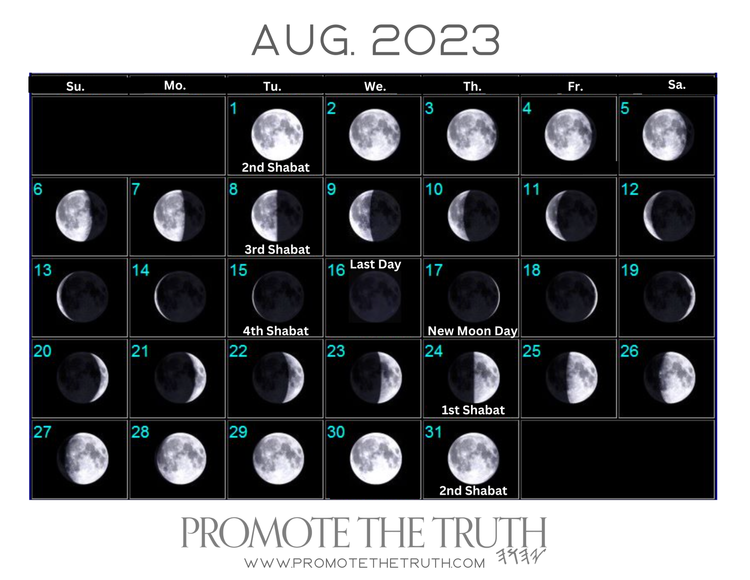When Does a Day Truly Begin: Unveiling the Deception
Introduction
In today's world, the concept of when a day begins has been clouded by misconceptions and falsehoods. The widely accepted belief that a day starts at midnight or sunset is rooted in erroneous teachings and man-made calendars. However, a careful examination of Scripture reveals the truth: a day actually begins at dawn. This article aims to dispel the darkness of tradition and shed light on the accurate understanding of when a true day begins.
The Scriptural Definition of a Day
In Barashiyt (Genesis) 1:5, we find a clear indication of how the Creator defines a day. However, most English Translations incorrectly translate this verse right way. In most English Translations, they write something like "And Aluah (“God”) called the light Day, and the darkness He called Night. And the evening and the morning were the first day." This is wrong. The correct translation for Barashiyt (Genesis) 1:5 is “And Aluah called the light Day, and the darkness He called Night. After the first day had completed, then the evening and morning came. This formed the first date.” This verse establishes a fundamental principle that a day is composed of only the light. The Scriptural definition of a day aligns with the natural order of the world, where daylight transitions into darkness and then back into daylight. The correct translation above is just one example of the countless others mistranslations that will properly be revealed and translated correctly in our upcoming release of the “Truth Scriptures.” More information can be found on our website under the “Contribute” tab.
Understanding the Nature of Light and Darkness
To comprehend why a day begins at dawn and ends at dusk, it's essential to recognize the significance of light and darkness in the natural world. The Creator, in His infinite wisdom, designed the celestial bodies, the sun, and the moon, to govern the day and the night. Tahliym (Psalms) 136:9 states, "The moon and stars to rule by night: for His loving comittment endures forever." Additionally, Yirmiyahu (Jeremiah) 31:35 affirms, "Thus said YAHUAH, who gives the sun for a light by day, and the laws of the moon and the stars for a light by night, who stirs up the sea, and its waves roar – YAHUAH of hosts is His Name." These verses emphasize the role of the moon, stars, and sun in establishing the rhythm of day and night.
The Deception of the Gregorian Calendar
Unfortunately, the current prevailing global Gregorian Calendar, with all of its pagan holidays, which dominates the lives of billions of people, has misled us into believing that a day starts at midnight. This man-made calendar, introduced by Pope Gregory XIII in 1582, operates on a fixed pattern of 365 days per year, with leap years every four years. However, the Gregorian Calendar fails to align with the Scriptural principles of timekeeping, disregarding the Creator's design. By overlooking the natural order and the separation of light and darkness, the Gregorian Calendar perpetuates a false understanding of when a day truly begins.
Challenging the Sunset Tradition
In Jewish tradition, the idea that a day starts at sunset is an entrenched belief that has shaped the faith's rituals and observances for centuries. This concept, however, does not stand up to the scrutiny of Scriptural interpretation. The initiation of a day at sunset would fundamentally contradict the Creator's explicit action of separating light from darkness, as depicted in the earliest passages of the Scriptures.
Understanding this calls for a reassessment of traditional beliefs and an openness to align our practices more closely with the Creator's original design. By basing our definition of a day on the onset of darkness, we create an inherent discordance with the Scriptural representation of the day as a period of light. The idea that a day begins with darkness stands contrary to the divine order set forth in Barashiyt (Genesis), where the Creator separated the light from the darkness and specifically labeled the light as "Day." It suggests a day being born out of darkness, a notion that finds no foundation in the Creator's words.
Therefore, challenging the sunset tradition involves not only reassessing traditional beliefs but also navigating the complexities of long-held practices. It requires courage and conviction, and a commitment to aligning our understanding more closely with Scriptural truth. Our objective should not merely be the questioning of tradition for its own sake, but the pursuit of a more profound, more authentic understanding of our relationship with time as intended by the Creator. In confronting the sunset tradition, we can foster a renewed commitment to align our practices with the Creator's design. Such a commitment does not diminish the richness of our faith but rather enhances it, providing a deeper, more authentic understanding of our spiritual obligations and the nature of our existence in accordance with the Creator's grand design. This understanding enables us to observe the Shabat (Sabbath) more accurately, beginning at dawn and ending at dusk, as prescribed by YAHUAH Himself.
Embracing the Dawn: The True Beginning of a Day
To discover the true commencement of a day, we must turn our attention to the break of dawn. As the first rays of sunlight pierce through the darkness, a new day is born. This moment of transition, when darkness gives way to light, aligns perfectly with the Scriptural definition of a day. The Savior Himself, Yahusha, affirmed this understanding in Yahuhanan (John) 11:9, asking, "Are there not twelve hours in a day?" This question implies that a day is composed of twelve hours of daylight, starting from dawn and concluding at dusk.
The concept of twelve hours in a day holds great significance in understanding the true beginning and end of a day. The number twelve carries symbolic weight throughout Scripture, representing completeness and divine order. By acknowledging twelve hours in a day, we honor the divine design of time and align ourselves with the Creator's intentions. This understanding allows us to embrace the dawn as the true starting point of a day and appreciate the rhythm of creation.
The Practical Implications
Recognizing that a day begins at dawn and ends at dusk has practical implications for our lives. By aligning our daily activities with the natural order, we can experience a deeper connection with the Creator and His creation. As the sun rises, we can seize the opportunity to embark on new beginnings, setting intentions for the day ahead. Conversely, as the day draws to a close, we can reflect on our actions and find rest in the evening, preparing for the next day's dawn.
Rediscovering YAHUAH's Calendar
Embracing the true start and end of a day at dawn and dusk leads us to question the validity of the man-made Gregorian Calendar. Instead, we can turn to YAHUAH's Calendar, which incorporates the lunar and solar cycles to establish a holistic and Scriptural timekeeping system. YAHUAH's Calendar recognizes the significance of the moon and the sun in determining the lunar months and the appointed times. By adhering to this calendar, we honor the Creator's design and restore our connection to His divine order. YAHUAH's Calendar allows us to see its deep interconnectedness with the natural world. This divinely ordained timekeeping system captures the essence of the Creator's grand design, with the celestial bodies serving as a cosmic clock. It appreciates the lunar cycle's nuances, uses them to demarcate months, and aligns the significant feasts and observances with the solar cycle's rhythm.
In essence, YAHUAH's Calendar, unlike man-made calendars, mirrors the cyclical patterns found in nature and encourages us to live in harmony with these cycles. This alignment connects us more intimately with the Creator's plan, enhances our spiritual experience, and deepens our understanding of the Creator's commands, such as the observation of the Shabat (Sabbath). As we commit ourselves to this calendar, we not only rectify the inaccuracies propagated by man-made systems but also affirm our commitment to living according to YAHUAH's divine order.
The Misleading Influence of the Gregorian Calendar and Erroneous Teachings on the Shabat (Sabbath)
Observing the Shabat (Sabbath) correctly is paramount to adhering to the teachings of the Creator, YAHUAH, as commanded in Shamut (Exodus) 20:8-11. A common misunderstanding arising from incorrect teachings and the pervasive influence of the Gregorian Calendar has skewed our understanding of when a day truly starts, leading us astray in our observation of the real Shabat (Sabbath). The deceptive influence of the Gregorian Calendar, and erroneous teachings by some religious authorities, such as the Jewish religion, that promote the belief of a day starting at sunset, are thought to be part of a scheme by ha Shatan (Satan) to mislead the faithful.
The true beginning of a day, according to Scripture, is at dawn, and this has profound implications for the proper observance of the Shabat (Sabbath). By adhering to the truth that a day commences at dawn and concludes at dusk, we gain clarity on when the Shabat (Sabbath) should be observed.
Aligning with the Creator’s Design by Embracing the Daylight Observance of Shabat (Sabbath)
The Shabat (Sabbath) is not a period that extends from midnight to midnight, nor is it from sunset to sunset. Instead, the Shabat (Sabbath) is to be honored during the daylight hours, from the break of dawn to the dusk's setting sun (no more light at all). This daylight observance of the Shabat is an essential element of our spiritual duties, and in honoring it, we align ourselves with the Creator's intent.
This understanding of when to observe the Shabat (Sabbath) is not merely a matter of correcting a misinterpretation. It has deep spiritual significance. The Shabat (Sabbath) is a divine Command, a divine day set apart for rest and worship. When we observe the Shabat (Sabbath) during the daylight hours as intended, we align ourselves with the Creator's design and manifest our obedience to His commands.
Understanding the true beginning and end of a day is crucial for the correct observance of the Shabat. This observance is not merely a ritualistic adherence to a Commandment, but a profound acknowledgment of the Creator's design and a demonstration of our allegiance to His truth. By observing the Shabat from dawn to dusk, we stand against the deception of ha Shatan, uphold the Creator's natural order, and enter a more profound, authentic connection with YAHUAH.
Conclusion
In conclusion, the prevailing notions of when a day begins at midnight or sunset are overshadowed by the Scriptural truth that a day starts at dawn and ends at dusk. It is clear that the entrenched beliefs claiming a day begins at midnight or sunset are simply not true. The Scriptures explicitly define a day as commencing with the break of dawn and closing at dusk. By aligning ourselves with this divinely ordained rhythm, we not only adhere to the Creator's design but also foster a profound connection to His creation. We immerse ourselves in a more enlightened understanding of time, where each day holds true significance in the grand pattern of life as ordained by the Creator YAHUAH Himself.
In the face of deceptive constructs like the Gregorian Calendar’s midnight to midnight mechanism, as well as the the sunset tradition, we have a responsibility to dispel the darkness of these misconceptions and uphold the light of truth. We are invited to embrace the dawn, the true herald of a new day, and redefine our understanding of time according to the divine framework. By doing so, we reclaim our connection to YAHUAH's Calendar, which incorporates the natural lunar and solar cycles in a perfect symphony of timekeeping. Our journey towards this truth not only reconnects us with the Creator's divine order but also serves as a testament to our commitment to living a life in harmony with His Commands. In essence, the true understanding of when a day begins is not merely about accurate timekeeping, but an invitation to a deeper spiritual awakening and living by and promoting the truth.




